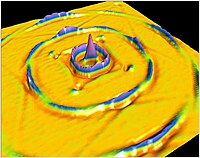
Photo from wikipedia
A flexible surface acoustic wave (SAW) strain sensor in the frequency range of 162–325 MHz was developed based on a single crystalline LiNbO3 thin film with dual resonance modes, namely, the… Click to show full abstract
A flexible surface acoustic wave (SAW) strain sensor in the frequency range of 162–325 MHz was developed based on a single crystalline LiNbO3 thin film with dual resonance modes, namely, the Rayleigh mode and the thickness shear mode (TSM). This SAW sensor could handle a wide strain range up to ±3500 μe owing to its excellent flexibility, which is nearly six times the detecting range of bulk piezoelectric substrate based SAW strain sensors. The sensor exhibited a high sensitivity of 193 Hz/ μe with a maximum hysteresis less than 1.5%. The temperature coefficients of frequency, for Rayleigh and TSM modes, were −85 and −59 ppm/ °C, respectively. No visible deterioration was observed after cyclic bending for hundreds of times, showing its desirable stability and reliability. By utilizing the dual modes, the strain sensor with a self-temperature calibrated capability can be achieved. The results demonstrate that the sensor is an excellent candidate for strain sensing.A flexible surface acoustic wave (SAW) strain sensor in the frequency range of 162–325 MHz was developed based on a single crystalline LiNbO3 thin film with dual resonance modes, namely, the Rayleigh mode and the thickness shear mode (TSM). This SAW sensor could handle a wide strain range up to ±3500 μe owing to its excellent flexibility, which is nearly six times the detecting range of bulk piezoelectric substrate based SAW strain sensors. The sensor exhibited a high sensitivity of 193 Hz/ μe with a maximum hysteresis less than 1.5%. The temperature coefficients of frequency, for Rayleigh and TSM modes, were −85 and −59 ppm/ °C, respectively. No visible deterioration was observed after cyclic bending for hundreds of times, showing its desirable stability and reliability. By utilizing the dual modes, the strain sensor with a self-temperature calibrated capability can be achieved. The results demonstrate that the sensor is an excellent candidate for strain sensing.
Journal Title: Applied Physics Letters
Year Published: 2018
Link to full text (if available)
Share on Social Media: Sign Up to like & get
recommendations!